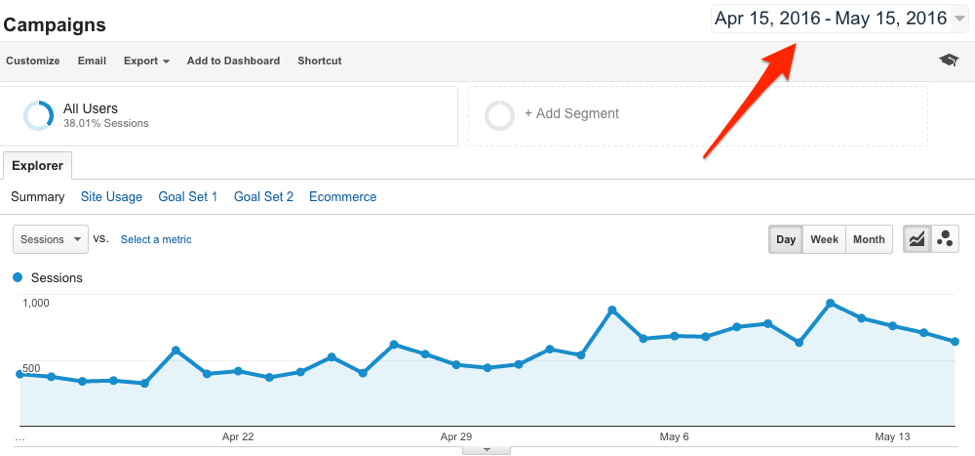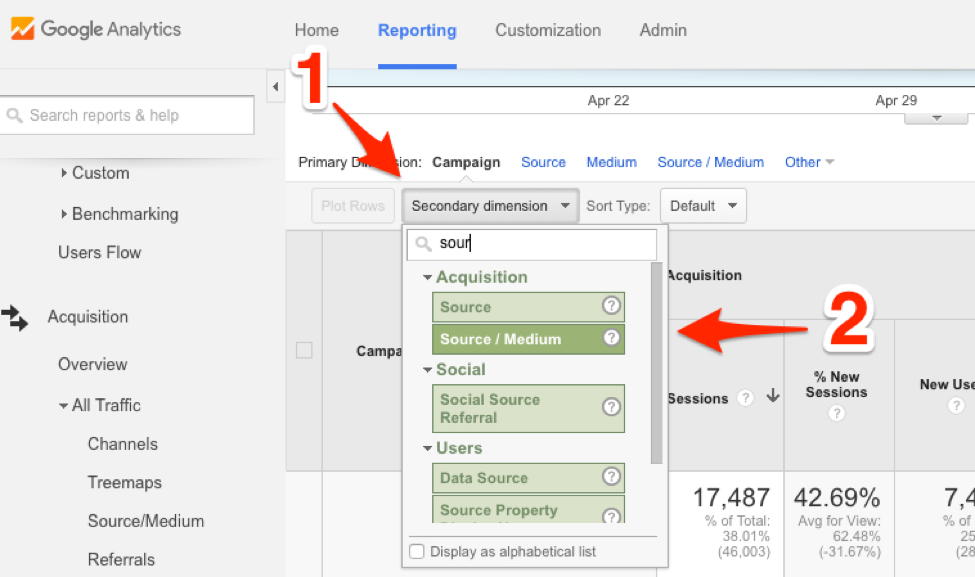If you run social media campaigns, you’ve probably wondered or been asked about the impact they're having. And sure, from basic Twitter Analytics and Facebook Insights you can tell you’ve received X number of clicks or generated Y impressions – but how does that impact the bottom line? The c-suite wants to see action, whether it’s web traffic, lead generation or online conversions. Lucky for you, you can find all of those metrics and more within Google Analytics.
Snapshot view
Acquisition -> Social -> OverviewThe overall social report gives you a snapshot view of what social networks are driving activity on your website. You can think of a session as a visit to your website. In this example, you see Facebook is driving the most traffic. It’s also important to note that paid traffic is not separated out in this view, so if you’re running any social media ads you’ll see that traffic also included here.

Specific social campaigns
Acquisition -> Campaigns -> All Campaigns If you’re publicizing content from your website and not using UTM codes on your URLs – take note! A UTM code is a snippet of text that you add to your URL in order to pass information back to Google Analytics. If you want to know how to make a UTM code for your own link, we wrote a blog about how to do that here. Once you have your URL, you can tweet or post it like you would any other link; it will even stay attached to your URL if you use a link shortener like Bitly.Navigate to the Campaigns report and you’ll see a list of campaigns driving users back to your website. If you don’t see your campaign listed, double check that your timeframe is correct in the top right corner of your Google Analytics page.

If you’ve created multiple links using the same campaign name (ex: one link for Twitter and another for Facebook, with the same campaign name for both), you can segment your data by adding a Secondary Dimension of Source/Medium. Click the “Secondary Dimension” box at the top of your table and select “Source/Medium” from the drop-down menu.

Now you’ll see your campaign listed for each network you specified as “campaign source” in your UTM link.
Referral traffic
Acquisition -> All Traffic -> ReferralsThe last place to check out for social media data is within the referrals report. Referrals within Google Analytics are the domains and pages where the user was directly before they arrived on your website.One thing you’ll notice in the referrals report is that your social networks may show up with both the full name (linkedin.com) and a shortened version (lnkd.in) of each domain. Over the past few years, several social networks created their own link shorteners to make it easier for users to natively share links on the platforms. To make sure you’re not leaving any social traffic out of your reporting, you can use advanced filters. Here’s one example of an advanced filter for LinkedIn traffic:

By choosing “Matching RegEx” from the drop-down menu next to “Source,” you can list out each domain you’d like to include in your report separated by a pipe. The pipe (usually on the same button as \ on your keyboard) acts as an “or” if you were to read your query like a sentence. Once you’re ready, hit Apply. In the above example, you’re telling Google Analytics: I want to include any source that matches linkedin.com or lnkd.in. Repeat this process for all of your social networks.Pro Tip for PR pros: Your referrals report is also a great place to look if you’ve secured media coverage and want to see whether any web traffic resulted from your hit. Instead of searching for a social network, search for your media outlet (ex: buzzfeed.com).
Ready to get started?
Whether you’re just getting started in PR or are an experienced pro, Google Analytics can provide you with the insights you need to transform your campaigns from guesswork to data-driven strategies. Ready to learn more about Google Analytics for PR pros? Download our free eBook today!
What’s a Rich Text element?
The rich text element allows you to create and format headings, paragraphs, blockquotes, images, and video all in one place instead of having to add and format them individually. Just double-click and easily create content.
The rich text element allows you to create and format headings, paragraphs, blockquotes, images, and video all in one place instead of having to add and format them individually. Just double-click and easily create content.
Static and dynamic content editing
A rich text element can be used with static or dynamic content. For static content, just drop it into any page and begin editing. For dynamic content, add a rich text field to any collection and then connect a rich text element to that field in the settings panel. Voila!
How to customize formatting for each rich text
Headings, paragraphs, blockquotes, figures, images, and figure captions can all be styled after a class is added to the rich text element using the "When inside of" nested selector system.



